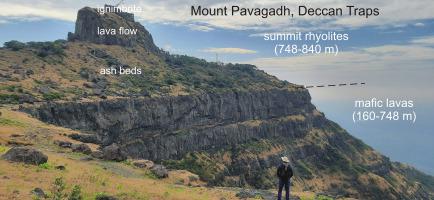当前位置:
X-MOL 学术
›
J. Volcanol. Geotherm. Res.
›
论文详情
Our official English website, www.x-mol.net, welcomes your
feedback! (Note: you will need to create a separate account there.)
Physical volcanology of the Pavagadh rhyolites, northern Deccan Traps: Stratigraphic, structural, and textural record of explosive and effusive eruptions
Journal of Volcanology and Geothermal Research ( IF 2.4 ) Pub Date : 2020-10-01 , DOI: 10.1016/j.jvolgeores.2020.107024 Janisar M. Sheikh , Hetu Sheth , Anmol Naik , Tanmay Keluskar
Journal of Volcanology and Geothermal Research ( IF 2.4 ) Pub Date : 2020-10-01 , DOI: 10.1016/j.jvolgeores.2020.107024 Janisar M. Sheikh , Hetu Sheth , Anmol Naik , Tanmay Keluskar

|
Abstract Mount Pavagadh (840 m) in the northern Deccan Traps, India, is mainly composed of mafic lava flows (picrites, ankaramites, mugearites, basalts) and capped by rhyolites. Rhyolites also found at lower elevations, on and around the mountain, are thought to represent blocks of the eroded upper rhyolites or local eruptions in situ. Although the Pavagadh sequence has been studied for 150 years, the stratigraphy, structures, textures, and physical volcanology of the Pavagadh rhyolites have been poorly documented, and are discussed here at length. The upper rhyolite sequence contains tens of non-welded, crystal-bearing, glass- and pumice-rich ash beds of 47 m total thickness. These represent a primary fallout ash succession derived from distant Plinian eruptions, possibly corresponding with massive ignimbrite deposits recently recognised in Saurashtra several hundred kilometers to the southwest. The fallout ash succession is overlain by a 50 m thick lava flow showing well-developed flow banding and folding, basal and upper breccias, and a local basal vitrophyre. The lava flow is overlain by an ignimbrite with a basal vitrophyre, both these units showing excellent vitroclastic textures. The upper rhyolites thus represent alternating explosive-effusive-explosive eruptions. The lower-level rhyolites in the area, showing intense rheomorphic deformation in outcrop but lacking vitroclastic textures, are probably also lavas. However, they are not blocks of the eroded upper rhyolite lava flow but from separate eruptions. The Pavagadh rhyolites were probably far more laterally extensive than their present outcrops, with a minimum original volume of 9 km3; their source areas remain unknown. Geochemical and geochronological work on the Pavagadh rhyolites is needed, in the stratigraphic and volcanological context provided here, to understand their petrogenesis and potential relationship with the Cretaceous/Palaeogene (K/Pg) boundary mass extinction.
中文翻译:

Pavagadh 流纹岩的物理火山学,北德干圈闭:爆炸性和喷发性喷发的地层、结构和质地记录
摘要 印度德干圈闭北部的 Pavagadh 山(840 m)主要由镁铁质熔岩流(苦味岩、安卡拉岩、穆格瑞石、玄武岩)组成,并被流纹岩覆盖。在山上和山周围的较低海拔处也发现了流纹岩,被认为代表了被侵蚀的上部流纹岩块或原位局部喷发。尽管 Pavagadh 层序已被研究了 150 年,但 Pavagadh 流纹岩的地层、结构、纹理和物理火山学的记录很少,在此详细讨论。上部流纹岩层序包含数十个总厚度为 47 m 的非焊接、含晶体、富含玻璃和浮石的灰层。这些代表来自遥远的普林尼亚火山喷发的主要沉降灰序列,可能与最近在索拉什特拉西南数百公里处发现的大量熔凝灰岩矿床相对应。50 m 厚的熔岩流覆盖在沉降灰层之上,显示出发育良好的流带和褶皱、基底和上部角砾岩以及局部基底玻璃岩。熔岩流上覆盖着带有基底玻璃岩的熔凝岩,这两个单元都显示出极好的玻璃碎屑纹理。因此,上部流纹岩代表交替的爆炸-喷发-爆炸喷发。该地区的低层流纹岩,在露头显示出强烈的流变变形,但缺乏体外碎屑结构,可能也是熔岩。然而,它们不是被侵蚀的上部流纹岩熔岩流的块,而是来自单独的喷发。Pavagadh 流纹岩可能比它们目前的露头横向广泛得多,最小原始体积为 9 平方公里;他们的来源地区仍然未知。需要在此处提供的地层和火山学背景下对 Pavagadh 流纹岩进行地球化学和地质年代学工作,以了解它们的岩石成因以及与白垩纪/古近纪 (K/Pg) 边界大灭绝的潜在关系。
更新日期:2020-10-01
中文翻译:

Pavagadh 流纹岩的物理火山学,北德干圈闭:爆炸性和喷发性喷发的地层、结构和质地记录
摘要 印度德干圈闭北部的 Pavagadh 山(840 m)主要由镁铁质熔岩流(苦味岩、安卡拉岩、穆格瑞石、玄武岩)组成,并被流纹岩覆盖。在山上和山周围的较低海拔处也发现了流纹岩,被认为代表了被侵蚀的上部流纹岩块或原位局部喷发。尽管 Pavagadh 层序已被研究了 150 年,但 Pavagadh 流纹岩的地层、结构、纹理和物理火山学的记录很少,在此详细讨论。上部流纹岩层序包含数十个总厚度为 47 m 的非焊接、含晶体、富含玻璃和浮石的灰层。这些代表来自遥远的普林尼亚火山喷发的主要沉降灰序列,可能与最近在索拉什特拉西南数百公里处发现的大量熔凝灰岩矿床相对应。50 m 厚的熔岩流覆盖在沉降灰层之上,显示出发育良好的流带和褶皱、基底和上部角砾岩以及局部基底玻璃岩。熔岩流上覆盖着带有基底玻璃岩的熔凝岩,这两个单元都显示出极好的玻璃碎屑纹理。因此,上部流纹岩代表交替的爆炸-喷发-爆炸喷发。该地区的低层流纹岩,在露头显示出强烈的流变变形,但缺乏体外碎屑结构,可能也是熔岩。然而,它们不是被侵蚀的上部流纹岩熔岩流的块,而是来自单独的喷发。Pavagadh 流纹岩可能比它们目前的露头横向广泛得多,最小原始体积为 9 平方公里;他们的来源地区仍然未知。需要在此处提供的地层和火山学背景下对 Pavagadh 流纹岩进行地球化学和地质年代学工作,以了解它们的岩石成因以及与白垩纪/古近纪 (K/Pg) 边界大灭绝的潜在关系。











































 京公网安备 11010802027423号
京公网安备 11010802027423号